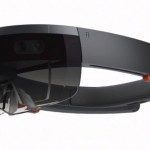Today at Microsoft’s Windows 10 press event, the company revealed an untethered augmented reality headset called the Microsoft HoloLens to accompany ‘Windows Holographic’, a component of Windows 10.
Microsoft has just revealed the HoloLens and says it is fully untethered, including a powerful CPU, GPU, and a dedicated processor that they’re calling the ‘holographic processing unit’ (HPU)—a dedicated chip to handle sensing and interpretation of the real world as revealed by on-board sensors. They’re calling it the “most advanced holographic computer the world has ever seen.”
Specs are limited right now, but the company said on stage that the display is “HD” and that the unit supports positional sound and has advanced sensors. In the photos we can see what appears to cameras hiding behind the outer lens.
Microsoft showed off a ‘HoloStudio’ app live on stage using the HoloLens device which allowed a user to construct a 3D object, augmented into the real world in front of them, using hand gestures. The AR program appeared to be tracked very steadily in the environment while in use.
The company says that Windows 10 has “holographic” APIs built into its core, allowing developers to create applications that are aware of—and projected into—the user’s real world.
“Want to create a device powered by human or environment understanding? Build for Windows 10. Oculus, Magic Leap, Glass developers and everyone else, we humbly invite you to come build for Windows 10,” the company said on stage.
See Also: Microsoft HoloLens Reveal Concept Video
Microsoft said they’ve been working on the device for “years,” and that the project’s lab was hidden, of all places, under the Microsoft Visitor Center.
From Microsoft’s build up to the reveal of the HoloLens, it sounds quite a bit like what the folks at Magic Leap have been teasing. Did Microsoft just beat them to the punch?
So yes, Microsoft is harping on “holographic.” Holo-this, holo-that… they’re not holograms in a technical sense, but the company is appealing to the public’s notion of a hologram being computer generated imagery that appears to be free-floating in the actual world. Of course, this is what augmented reality has always meant (but not quite delivered); it seems that Microsoft and others (like Magic Leap) want to dodge around what might be best called the tarnished notion of AR.
More Coverage:










